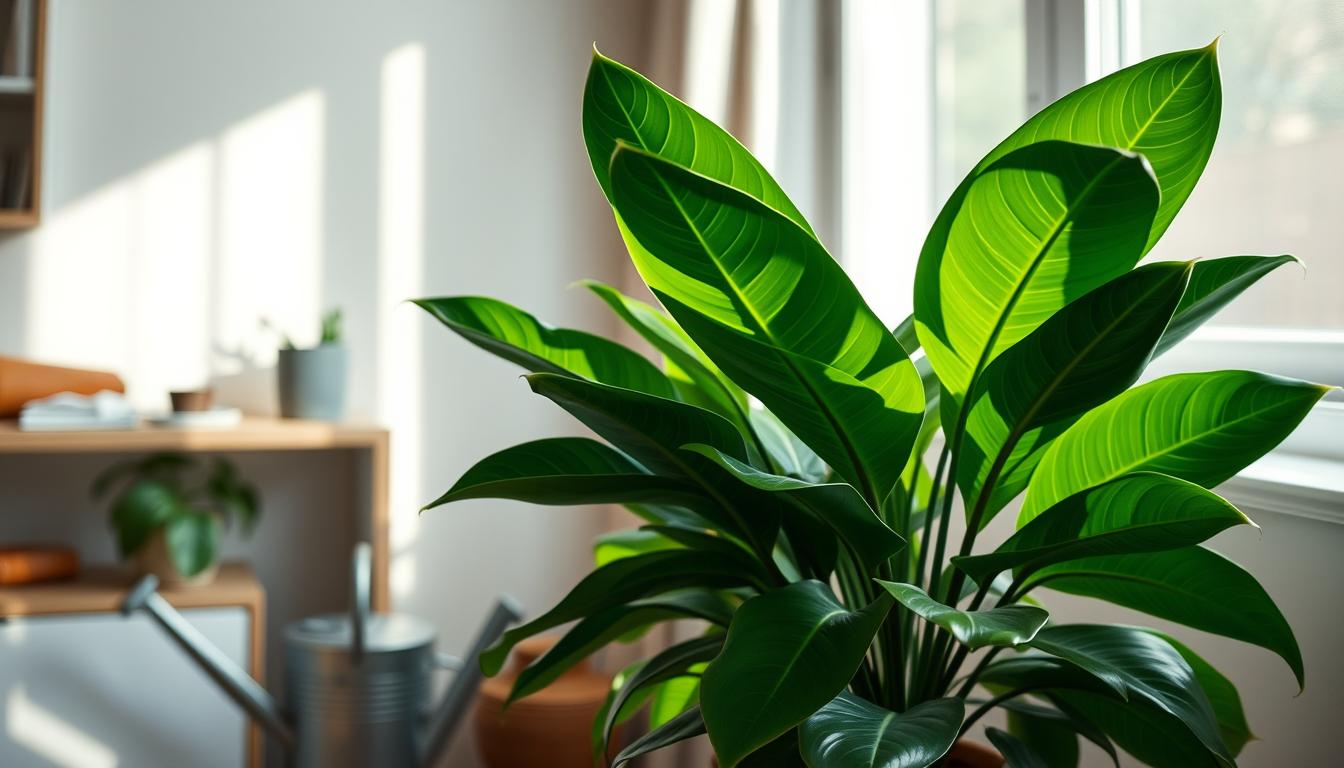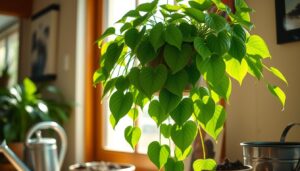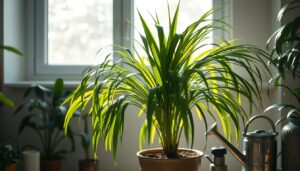Why do rubber plants make great indoor plants? They have shiny leaves and clean the air. They’re perfect for homes and offices.
Learning how to care for rubber plants is easy. You’ll find out how to make your indoor space beautiful and healthy. A good guide will help you do it.
Rubber plants are tough and look great. They grow well in many places. They’re perfect for anyone who loves plants.
With the right care, rubber plants can do amazing things. They can make your home or office look and feel better. Start caring for your rubber plant today and watch it thrive.
Introduction to Rubber Plants
Rubber plants, also known as rubber trees or ficus elastica, are great for indoor gardens. They need little care and have special traits. Knowing their history helps us care for them better.
These plants come from Southeast Asia. They’ve been used for making natural rubber. Now, they’re popular for indoor gardening.
Rubber plants can grow big indoors, up to 6 to 10 feet tall. Their leaves are 8 to 12 inches long. There are many varieties, each unique.
What is a Rubber Plant?
A rubber plant is a type of ficus. It has big, dark green leaves. It’s easy to care for and looks great indoors.
Brief History and Origins
Rubber plants have a long history. Their latex was used to make natural rubber. Now, they’re loved for their beauty and easy care.
Popular Varieties of Rubber Plants
There are many rubber plant varieties. The ‘Rubra’ and ‘Robusta’ are popular. The ‘Rubra’ has leaves that start red and turn green with red edges. The ‘Robusta’ has leaves up to 18 inches long.
- Provide bright, indirect light
- Maintain a consistent temperature between 60°F to 75°F
- Water thoroughly, allowing soil to dry slightly between watering sessions
- Fertilize every two weeks during active growth in spring and summer
By following these tips, you can enjoy your rubber plant. They’re beautiful and easy to care for.
Ideal Growing Conditions for Rubber Plants
To make your rubber plant happy, give it the right home. It loves bright, indirect light. This is perfect for rooms with north or east windows. If it’s not too bright, it’s okay, but it might grow slower.
Keep the temperature and humidity just right. Too much change can upset the plant. A comfy spot is best.
For the best care, watch the temperature and humidity closely. The ideal range is 60° to 85° F. Humidity should be 40% or more. You can use a tray with water and pebbles or a humidifier to help.
- Light: Bright, indirect light, but can tolerate lower light conditions
- Temperature: 60° to 85° F
- Humidity: 40% or higher
Follow these tips to make your rubber plant thrive. With the right care, it will do great.
| Factor | Ideal Condition |
|---|---|
| Light | Bright, indirect light |
| Temperature | 60° to 85° F |
| Humidity | 40% or higher |
Watering Your Rubber Plant
Watering is key for Rubber Plant care indoor. The soil should be moist but not too wet. Wait until the top inch of soil is dry before watering.
Check soil moisture by sticking your finger in it. If it’s dry, it’s time to water. Watch for signs of too much or too little water.
Here are some tips for watering your Rubber Plant:
- Water when the top inch of soil is dry to the touch.
- Avoid getting water on the leaves to prevent fungal diseases.
- Use room-temperature water to prevent shocking the roots.
| Pot Size | Soil Dryness Before Watering |
|---|---|
| 4-inch pot | Top 1/2 inch |
| 15-inch pot | Top 2-3 inches |
Soil and Potting Needs
For Rubber Plant care, the right soil and potting are key. A good potting mix keeps water out of the roots. This stops root rot. Learn more about Rubber Plant care tips to help your plant grow.
Choose a pot that’s just a bit bigger than the plant’s roots. This stops the soil from getting too wet. Here are some tips:
- Use a well-draining potting mix to prevent waterlogged soil.
- Choose a pot that is not too large, as this can cause the soil to become too wet.
- Consider the size of the plant’s root ball when selecting a pot.
By following these Rubber Plant care tips, your plant will do well. Water when the top 2 inches of soil is dry. Fertilize often for the best growth. With the right soil and pot, your Rubber Plant will be happy and healthy.
Fertilization Tips for Rubber Plants
Fertilizing your Rubber Plant is key to its health. It needs nutrients for growth and green leaves. Use a balanced, water-soluble fertilizer every 4-6 weeks when it’s growing.
It’s important to follow the fertilizer’s instructions. Too much can harm your plant. Use a fertilizer with a balanced N-P-K ratio, like 10-10-10 or 5-1-1.
- Use a balanced, water-soluble fertilizer
- Apply the fertilizer every 4-6 weeks during the growing season
- Follow the manufacturer’s instructions for the correct dosage
- Monitor your plant for signs of overfertilization
| Fertilizer Type | N-P-K Ratio | Application Frequency |
|---|---|---|
| Balanced, water-soluble fertilizer | 10-10-10 | Every 4-6 weeks |
| Slow-release fertilizer | 5-1-1 | Every 3 months |
By following these tips, your Rubber Plant will grow well. It will have beautiful, green leaves.
Pruning Your Rubber Plant
Pruning is key to keep your Rubber Plant looking good. Use clean, sharp tools to avoid spreading diseases. Prune in late spring or early summer when the plant is growing fast.
This helps the plant heal quickly and keeps it healthy. Pruning is a must for your Rubber Plant’s care.
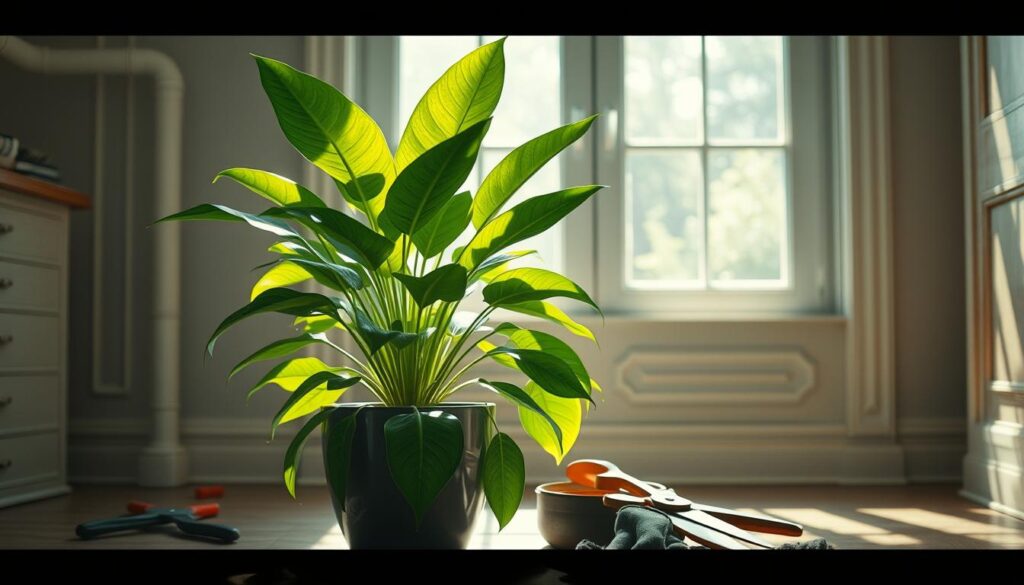
- Prune in the late spring or early summer for best results
- Use clean, sharp tools to prevent spreading diseases
- Make cuts at a 45-degree angle just above a node to stimulate new growth
- Remove any dead or damaged leaves or stems to prevent the spread of disease
Follow these tips to keep your Rubber Plant happy and healthy. Always use clean tools and prune at the right time. This way, you’ll get the best results.
| Pruning Tip | Benefit |
|---|---|
| Prune in late spring or early summer | Allows plant to heal quickly and reduces risk of disease |
| Use clean, sharp tools | Prevents spread of disease |
| Make cuts at 45-degree angle | Stimulates new growth |
Troubleshooting Common Issues
As a rubber plant owner, you might see pests, diseases, or watering problems. Check your plant often to spot these issues early. Spider mites, scale, and mealybugs can harm your plant. Learn more about common rubber plant problems and how to fix them.
To avoid these problems, follow Rubber Plant care best practices. This means watering and fertilizing right. Too much water can rot the roots, while too little can make leaves droop. Keeping a good watering schedule is key for your plant’s health. Rubber Plant care indoor also means watching humidity, temperature, and light.
Some common issues and their solutions include:
- Yellowing leaves: adjust watering schedule and improve drainage
- Brown spots: check for overwatering and adjust watering schedule
- Pests: inspect plant regularly and treat with insecticidal soap if necessary
By following these tips and being careful with Rubber Plant care best practices, your plant will stay healthy. Always watch your plant and act fast if you see any problems.
| Issue | Solution |
|---|---|
| Overwatering | Allow soil to dry almost completely between waterings |
| Underwatering | Water plant every 1-2 weeks, depending on environmental conditions |
| Pests | Inspect plant regularly and treat with insecticidal soap if necessary |
Propagating Rubber Plants
Exploring Rubber Plant care opens up a world of fun. You can share plants with friends or grow more for yourself. To do this right, follow some key tips. Stem cuttings are a popular way to start new plants. Take a cutting from the top of a grown plant and put it in water or moist soil.
When you cut stems, keep them warm and bright. The best temperature for growing is at least 25 °C. Cut stems should be 5 to 10 cm long. Node cuttings should be 3 to 4 cm long. This way, you’ll have a good chance of growing new plants.
- Maintaining a humid environment to promote root growth
- Providing dappled sunlight to prevent leaf burn
- Applying rooting hormone to the cut end of each cutting
- Keeping the cuttings in a warm, bright spot
By following these tips, you can grow new rubber plants. This way, you’ll enjoy the many benefits they bring.
Repotting Your Rubber Plant
As your rubber plant grows, it might outgrow its pot. This means it’s time to repot. A good Rubber Plant care guide says to repot every 1-2 years. Or when the plant’s roots fill the pot.
The best time to repot is in spring. This is when the plant grows the most.
When you repot, pick a pot that’s just a bit bigger. This keeps the soil from getting too wet. A Rubber Plant care instructions will tell you to use a mix that drains well. This stops the soil from getting too soggy.
Here are signs it’s time to repot:
- Roots growing out of drainage holes
- Stunted growth
- The plant becoming top-heavy
After repotting, water your plant well. This helps the soil settle. You can also add a balanced fertilizer. This helps your plant grow strong.
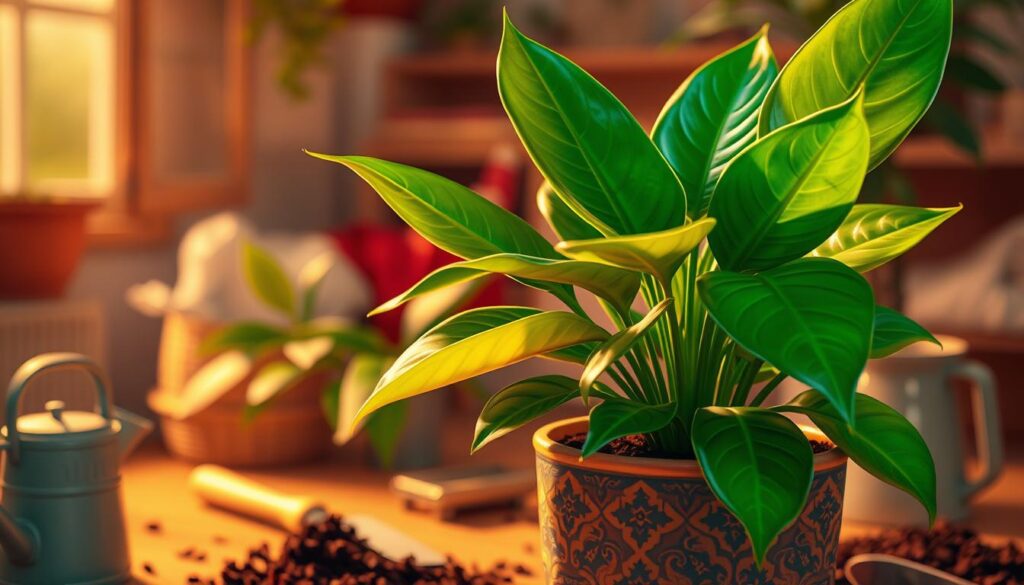
Be gentle with your rubber plant when repotting. Use a sheet to support it. This prevents leaves from breaking and sap from leaking.
| Repotting Frequency | Plant Size |
|---|---|
| Every 1-2 years | Small to medium-sized plants |
| Every 3 years | Larger plants |
Enhancing Aesthetic Appeal
To make your rubber plant look better, add it to your home decor. A good Rubber Plant care routine really helps. Pick a stylish pot to make it look great and match your home.
Here are some ideas for pretty pots for your rubber plant:
- Choose a pot that shows off your style, like modern or traditional.
- Find a pot that goes well with your plant’s leaves.
- Look for a pot with a cool shape or design.
When you put your rubber plant in your home, keep up with Rubber Plant care essentials. Make sure it gets enough light, water, and food. A nice pot and a healthy plant make a beautiful room addition.
Follow these tips to make your rubber plant look amazing. It will be a beautiful part of your home.
Rubber Plant Myths and Facts
Many people think Rubber Plants are hard to care for. But, this is not true. With the right care, they can grow well and look great in your home. To care for them indoors, give them bright, indirect light and keep the temperature above 60°F.
Rubber Plants can clean the air, making them good for indoor spaces. They don’t produce pollen, which is great for people with allergies. But, their sap can irritate skin. So, it’s important to be careful when handling them. By following the right care tips, you can enjoy having a Rubber Plant at home.
- Water your Rubber Plant sparingly, allowing the topsoil to dry out before watering.
- Fertilize your Rubber Plant during the growing season to encourage optimal growth.
- Prune your Rubber Plant with sterile shears to prevent sap contact and potential irritation.
By learning the truth and following care tips, you can enjoy your Rubber Plant. Always be gentle with it and make sure it has what it needs to thrive.
Conclusion: Embrace the Elegance of Rubber Plants
Starting a journey with a rubber plant is exciting. These plants are from the tropics of Southeast Asia. They have been loved by gardeners for over a century.
They look great, clean the air, and fit well in many homes. Rubber plants are perfect for adding nature to your space.
Follow the care tips in this guide to keep your plant happy. It will make your home look greener and nicer. Rubber plants are easy to care for and look amazing. Let them make your home feel like a tropical paradise.


